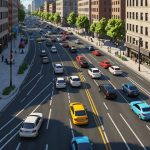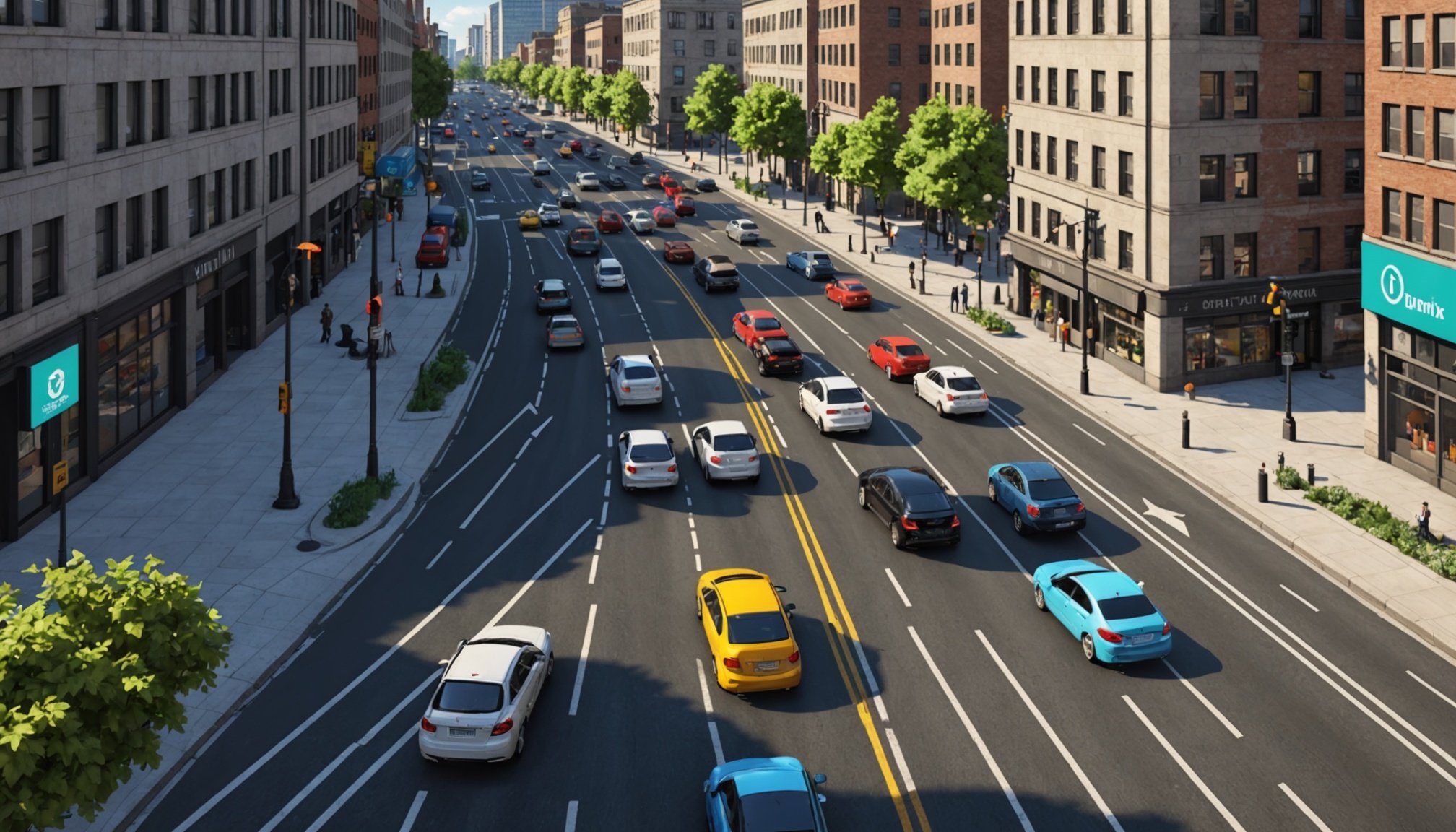Introduction to Realistic Traffic Generation
Realistic traffic patterns are crucial in urban simulations, providing depth and immersion in gameplay. Players increasingly demand authentic environments, and realistic traffic helps meet these expectations. By simulating real-world conditions, games can offer scenarios that are both engaging and challenging.
Urban simulation relies on traffic modelling to mimic the complexities of a bustling city. Advanced techniques, such as AI-driven algorithms, adjust traffic flows based on time of day and other variables, mirroring real-life situations. This authenticity not only enhances visual appeal but also improves strategic decision-making as players navigate complex traffic patterns.
This might interest you : Revving up realism: how real-time ray tracing transforms reflections in racing games
The impact on gameplay experience is profound, offering players a more dynamic and organic world. Enhanced traffic simulations result in unpredictable and diverse challenges, increasing replay value and user satisfaction. Modern simulation games, such as city-builders, employ these techniques to offer more than just static landscapes. Instead, they provide a living, breathing environment that reacts to player input and decisions.
Realistic traffic generation is therefore a cornerstone in modern simulations, pushing the boundaries of what games can achieve. These innovations facilitate a more enriched gaming experience, allowing players to explore integrated and sophisticated urban landscapes.
Analyzing Traffic Patterns in Popular Urban Simulation Games
Examining traffic patterns in urban simulation games provides insight into how developers create authentic, realistic gameplay. Implementing traffic analysis and reviewing case studies of successful simulations can inform the development of effective game models.
Overview of Successful Games
Popular urban games like Cities: Skylines and SimCity effectively simulate complex transportation systems. Each has a unique approach, with Cities: Skylines focusing on user-directed traffic management, while SimCity emphasizes broader urban planning elements. Both titles serve as prime examples of developing expansive, realistic traffic systems that respond dynamically to player actions and city growth.
Key Mechanisms that Drive Authentic Traffic
Successful simulation games utilize several mechanisms to build believable traffic systems. These include sophisticated AI algorithms, which dictate vehicle movement and congestion responses, and detailed road design tools. Such features enable responsive and adaptable traffic environments, allowing players to experience an immersive representation of urban dynamics.
Comparison of Different Simulation Approaches
Different games employ varied traffic analysis techniques to enhance realism. While some lean towards detailed micromanagement, others integrate regional strategies that mimic real-world urban challenges. By comparing distinctive simulation strategies, developers learn how to craft more engaging and authentic experiences, offering players insightful perspectives on city traffic systems.
Proven Techniques for Realistic Traffic Generation
Creating lifelike traffic patterns is crucial for an immersive simulation experience. Traffic generation techniques have evolved to incorporate sophisticated algorithms and real-world data, providing a dynamic environment that mirrors urban landscapes. Implementing these methods involves several gameplay strategies that transform virtual spaces into authentic urban networks.
To start, consider integrating simulation methods that utilize real-time data from GPS services. This allows the simulation to mimic actual traffic flow, adapting to variables like time of day and current events. You can enhance realism further by employing agent-based models where each vehicle operates based on individual parameters and behaviors, such as obeying speed limits or responding to road conditions.
Experimenting with varying scenarios also adds depth. Try alternating between peak-hour conditions and late-night traffic, or simulate the impacts of roadworks and accidents. This creates a nuanced environment that challenges and refines your gameplay strategies.
Documented strategies prove that variance in vehicle types, from buses to private cars, enriches the traffic landscape. A step-by-step guide might involve strategically placing key intersections and adjusting pedestrian movements to balance flow and congestion effectively. As these techniques blend, they enhance the effectiveness of your simulated world, offering a more engaging and realistic experience.
Overcoming Common Challenges in Traffic Simulation
Navigating the world of traffic simulation challenges requires insight into the intricacies of urban development and traffic flow management.
Identifying Key Issues in Traffic Patterns
Understanding traffic simulation involves recognizing common pitfalls. Inaccurate data input, unrealistic modeling of driver behavior, and neglect of external factors like weather can skew results. The complexity of simulating intersections and road diversions often leads to inconsistencies in predicted patterns.
Solutions for Enhanced Traffic Management
Overcoming these obstacles entails using enhanced analytical tools and techniques. Implement adaptive algorithms that account for real-world unpredictability, such as sudden lane changes or pedestrian crossings. Adjustments to data accuracy and regular updates can drastically improve simulation outcomes. Implementing tactical solutions involves integrating machine learning models to predict future traffic patterns based on historical data.
Tools for Diagnosing Traffic Simulation Problems
To diagnose traffic simulation issues, developers should employ robust diagnostic tools. Utilities that highlight discrepancies in traffic flow allow for swift corrections. Simulation software with diagnostic tools such as visual analytics can identify problem sources. Tailoring these tools to fit the specific needs of each urban environment and continually testing new scenarios will improve accuracy and reliability in traffic models. Adaptation is key for successful traffic management, catering to the dynamic nature of urban development.
Impact of Realistic Traffic on Game Dynamics
Traffic behavior plays a crucial role in shaping game dynamics and player engagement. Realistic traffic simulations prompt players to make strategic decisions, as they navigate through congested and fluid in-game environments. This adds depth to gameplay, leaving players with a sense of accomplishment after successfully manoeuvring through complex traffic scenarios.
Player feedback indicates a strong preference for games that incorporate authentic traffic patterns. With realistic traffic, gamers feel more immersed and engaged, as they must anticipate and respond to their surroundings, much like in real-world driving experiences. This adds an additional layer of challenge and excitement, encouraging players to remain invested in the game for longer durations.
In terms of game narratives, realistic traffic patterns can have significant long-term effects. By reflecting real-world traffic behavior, developers can create dynamic game worlds where events unfold in a natural and plausible manner. This authenticity not only enhances the storytelling aspect but also influences player choices, leading to diverse narrative outcomes. Ultimately, integrating realistic traffic into game dynamics creates more compelling and memorable game experiences, fostering a loyal player base.
Visual Aids and Tutorials for Traffic Simulation
Leverage the power of visual tools and tutorials to enrich your understanding of traffic generation. These aids are instrumental in bringing simulations to life, offering clarity and enhancing learning.
Importance of Visual Representation in Simulation
Visual representation in simulations is crucial. It helps in visualising concepts that are otherwise abstract. By seeing the traffic patterns, a learner can better grasp how different elements interact within a system.
Recommended Tools and Resources
There exist a variety of tutorials and educational resources available online. Tools such as VISSIM and MATSim are popular choices. Each of these provides intuitive interfaces that aid in constructing real-world scenarios effortlessly, enabling in-depth exploration.
Sample Tutorials with Screenshots
Utilising step-by-step tutorials that include screenshots can significantly improve one’s grasp of traffic simulation methods. A typical example is building a city traffic model. Screenshots guide users through software interfaces, providing a clearer understanding of each stage. This approach not only fosters learning but ensures effective implementation of traffic generation processes into your projects.
Future Trends in Traffic Simulation for Urban Games
In the ever-evolving realm of simulation games, future trends are set to transform how traffic management is depicted. Technological advancements are influencing game design, leading to more realistic and dynamic simulations. For instance, the integration of AI and machine learning could allow for more responsive in-game environments, adapting to player behavior and traffic patterns more seamlessly.
Predictions for the next generation of traffic simulation techniques include the use of real-time data to replicate actual urban environments within the game. This innovation might involve incorporating live traffic feeds, resulting in simulations that react in real-time to the fluctuations found in metropolitan traffic. By steering away from static models, developers aim to create experiences that mirror the fluidity of real-world scenarios.
Community feedback is pivotal in shaping future developments, highlighting the desire for more immersive and interactive experiences. Players increasingly demand features that reflect the complexities of authentic urban traffic systems. Innovations in this area will likely focus on enhancing player engagement by addressing these evolving expectations. In this cycle of evolution, simulation games are poised to become more than just entertainment, offering deeper insight into the complexities of urban planning.






